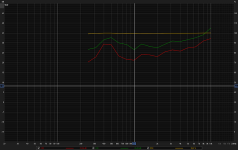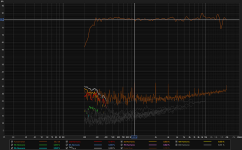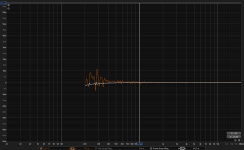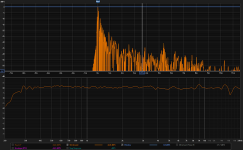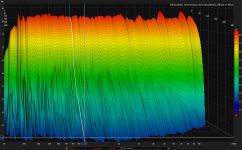I made some more recordings from a listener's perspective (the hotspot on the couch, 3 meters/10ft from the speakers) using the binaural microphones at hand. The Sony DV recorder handles the A-D conversion, I don't know how well the converter is in the recorder, but it works. I think the recordings give a nice overview of how my speakers and room sound. It is VERY recommended to play back using decent headphones, the binaural effect is not great on regular speakers, and your acoustics are laid over the recording which in this case is not optimal and could sound hollow. Hope you enjoy it, let me know 🙂
The video quality HD is probably overkill, both files contain some 500Mb of data so do not view these when data restricted....
Songs: Randy Brecker - Streeange
Sven Vath - from album Contact
The video quality HD is probably overkill, both files contain some 500Mb of data so do not view these when data restricted....
Songs: Randy Brecker - Streeange
Sven Vath - from album Contact
Please allow me to share some nearfield measurements of the Le'Cleach 3D printed horn with the BMS driver. The microphone is placed a few centimeters (approx. one inch) from the mouth, more or less on axis. Only one measurement is used, no averaging of multiple measurements. The SPL is "full throttle" on the <0,5watt tube amps 🙂
The horn is where it normally sits, so the (left) wall is in proximity. I placed some 2" acoustic foam on the floor and against the wall next to the horn. I did not use windowing or other fancy settings (still have to learn how to properly use it). A MiniDSP 8x10HD has been used to set the crossover and delay, and a few PEQ's to correct for some peaks and dips with max. +- 5dB. I struggle with the dip at 16kHz (although it does not bother me as I cannot hear that high pitch anymore due to aging), and in the impulse response there is something happening at 22ms, I do not understand what causes this. Maybe someone has more experience in tracing the possible cause? Comments to the graphs welcome, even bad ones ;-)







The horn is where it normally sits, so the (left) wall is in proximity. I placed some 2" acoustic foam on the floor and against the wall next to the horn. I did not use windowing or other fancy settings (still have to learn how to properly use it). A MiniDSP 8x10HD has been used to set the crossover and delay, and a few PEQ's to correct for some peaks and dips with max. +- 5dB. I struggle with the dip at 16kHz (although it does not bother me as I cannot hear that high pitch anymore due to aging), and in the impulse response there is something happening at 22ms, I do not understand what causes this. Maybe someone has more experience in tracing the possible cause? Comments to the graphs welcome, even bad ones ;-)
Yesterday I decided to take a fresh look at the optimalisation of the exponential midbass horns covering roughly 90-400hz. I made some nearfield measurements of the results, the mic is placed at a couple of cm's on axis in front of the horn and about 15cm's above the floor. The speaker is where it is normally placed, so room interactions do have some influences, but I was surprised that did not really play havoc with the measurements. Some acoustic damping is temporily applied against the left wall. I do not use a traditional crossover for this horn, but I have used some moderate PEQ equalizing the curve. A 24dB LR low pass at 920hz has been applied, as well as a subsonic filter.





Found out that that was the backwall reflection 😎and in the impulse response there is something happening at 22ms
Midbass folded horn design called the MIGhorn: Exponential horn for 8" woofer, 1800cm2 mouth, path length plm. 106cm.

I was not satisfied with optimization of the mid-high Le'Cleach horn and decided to do it again, this time I placed a table in the middle of the room, with the horn on top, to be able to use windowing analysis. The ceiling and floor were closest to the mic and speaker, so a window of 2ms start and 4ms end is used for the analysis. The mic is placed one meter from the throat, so 57cm from the mouth. I used some manual peqs to correct the curve (no REW EQ used). Pity that my horn is not hifi... still good to scare something 😉







Last edited:
Additional, I made a polar measurement with 10 degrees increment from 0 degrees to 90 degrees. With thanks to @mabat for the simulation below (see picture), I finally went for the hassle to produce a 0-90 degrees measurement. This is where my horn is compromised, it is beamy. I like that though, and for me it is not a problem because I treated the room such that the sound is direct but not in your face, there is a proper soundstage. So you hear the recording ambiance and precise placement of notes/sounds due to the absence of first reflections. The room boundaries seem to have disappeared so to say.


Gee- that is smooth ! (plus lovely in aesthetics) -your midbass horn is certainly nice too.
3D printer manufacturers always forget about decent filament runout and jamm sensor and also forget implement M600 command. Not mention it can't hit same position after power surge. They are very unreliable for large prints. Best is to take Klipper based printers easier to tweak in future.I tied that, somehow i messed up.
Small wonder I made it... second pair of horns underway, but at the moment no time to finish. My printer- a Renkforce RF2000 which I assembled myself- seldom jam, you need to tweak it properly. Running out of filament is a matter of planning (weighing). I can get very repeatable results, which you need when you want to print a horn this big.3D printer manufacturers always forget about decent filament runout and jamm sensor and also forget implement M600 command.
RF2000 is like tank with interesting extruder force sensor.
Your big horn - no "megaphone" sound? I remember 200Hz JMLC sounded like megaphone alone so I concluded 350Hz largest "full range".
Your big horn - no "megaphone" sound? I remember 200Hz JMLC sounded like megaphone alone so I concluded 350Hz largest "full range".
Uhm, no. That would also show up in the measurements I reckon, but I wouldn't listen to a megaphone 😉 . It has smoothly rising DI though (beamy), some find that problematic but I like it.Your big horn - no "megaphone" sound?
A brief update regarding the mid/high Le'Cleach 300Hz horn -using the BMS 4592ND coaxial driver- in my new listening room, after my relocation. Busy with furnishing, building a new kitchen, you know... I finally got some time to fiddle with the DSP. I started from a clean sheet, took some measurements within the passbands of the drivers, without any crossover and PEQ's. I put the mic on axis about 1 feet/30cm of the horn. The horn is in it's normal position for auditioning, about 20cm from the side wall and about 6foot from the back wall, both of which have 5cm damping applied. The wooden floor is about 2.5ft (75cm) below the axis of the horn and the ceiling 5.5ft. I intend to take outside measurements as well but I will have to organize that, dragging equipment outside. But no neighbours in half a mile distance and a very quiet environment especially in the evenings, that's a bonus.
After some tweaking using indoor measurements, the final measurement that is posted below shows 200-20000 Hz with crossover between mid and high sections, and a "low shelf" PEQ below 3000 Hz of -3dB to compensate a shallow rising slope with lower frequencies, and a "peak" PEQ at 3000Hz of -4dB to remove a little bump between 2kHz and 4kHz. No additional corrections applied yet and to be optimised further. Sounds already O.K. to my ears. 1/48th smoothing.

After some tweaking using indoor measurements, the final measurement that is posted below shows 200-20000 Hz with crossover between mid and high sections, and a "low shelf" PEQ below 3000 Hz of -3dB to compensate a shallow rising slope with lower frequencies, and a "peak" PEQ at 3000Hz of -4dB to remove a little bump between 2kHz and 4kHz. No additional corrections applied yet and to be optimised further. Sounds already O.K. to my ears. 1/48th smoothing.
Last edited:
Some additional graphs, acquired from the above measurement.
Attachments
- Home
- Loudspeakers
- Multi-Way
- 3D printed horn system
